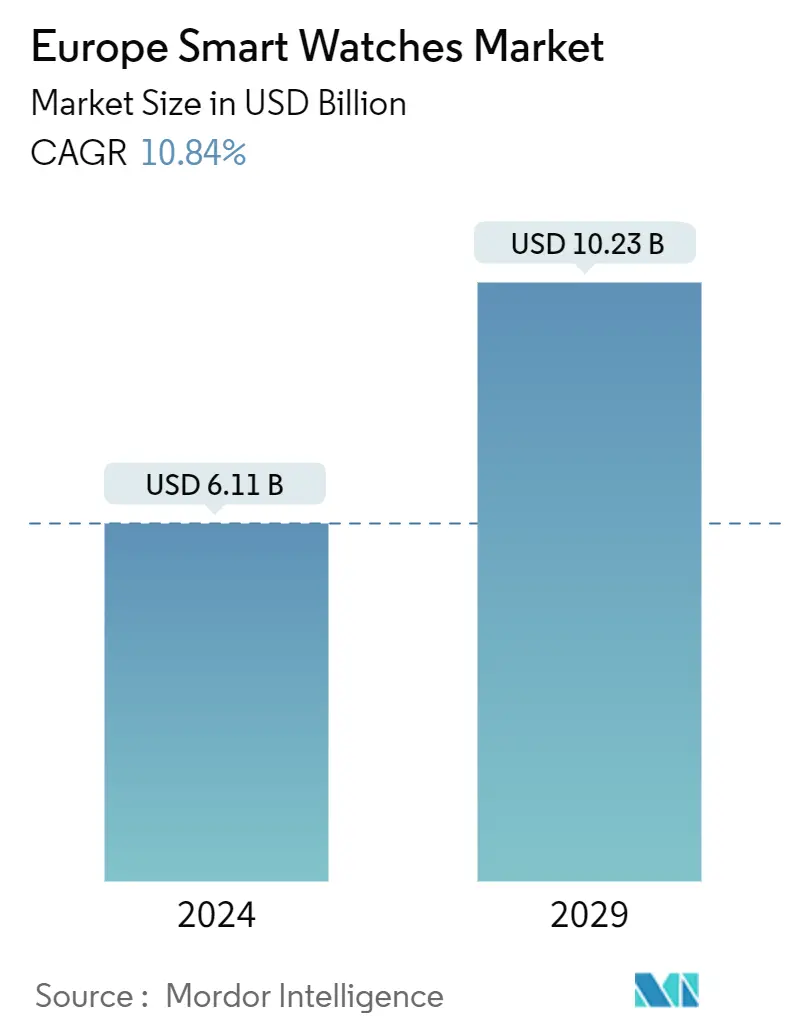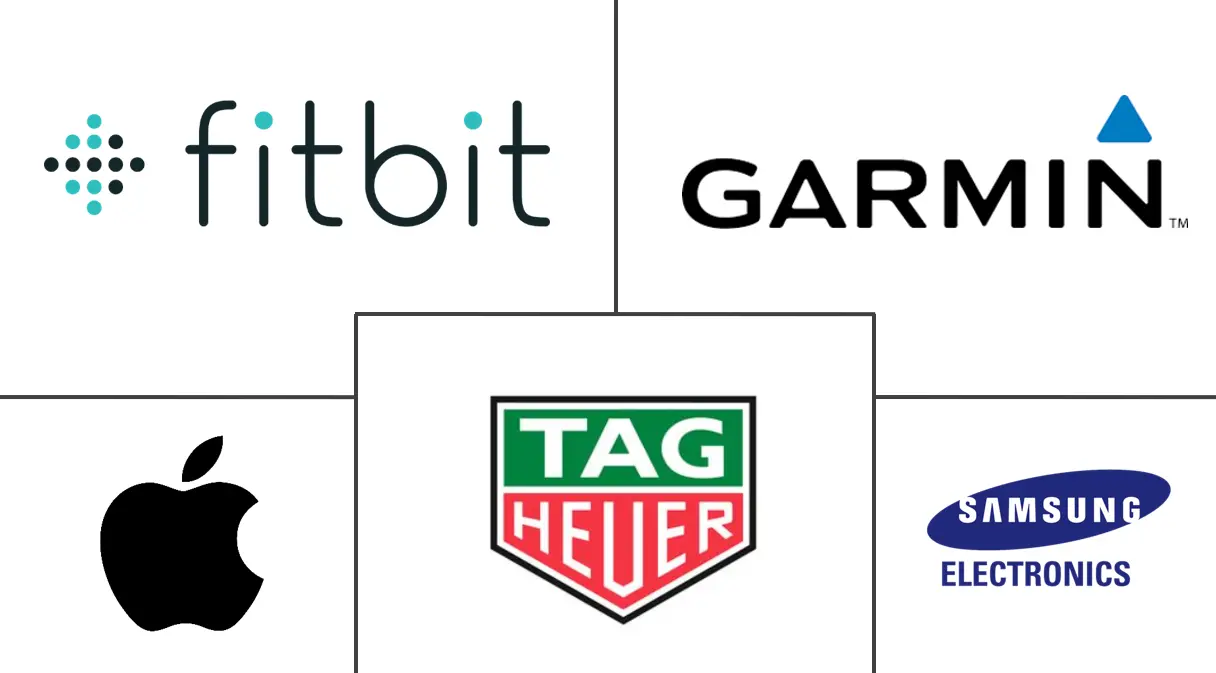Market Size of Europe Smart Watches Industry

| Study Period | 2019 - 2029 |
| Base Year For Estimation | 2023 |
| Market Size (2024) | USD 6.11 Billion |
| Market Size (2029) | USD 10.23 Billion |
| CAGR (2024 - 2029) | 10.84 % |
| Market Concentration | Low |
Major Players
*Disclaimer: Major Players sorted in no particular order |
Europe Smart Watches Market Analysis
The Europe Smart Watches Market size is estimated at USD 6.11 billion in 2024, and is expected to reach USD 10.23 billion by 2029, growing at a CAGR of 10.84% during the forecast period (2024-2029).
- Smartwatch is becoming popular for providing hands-free control and access to data anywhere at any time. Apart from this, biometric functionality, GPS and mapping capability, and independent smartphone functionality are a few unique features of the smartwatch in line with the increasing disposable income of the people, which is expected to drive the market in European countries.
- With the growing number of connected cars in European countries, the number of features to be used via smart wearables is also increasing. According to Goldman Sachs, the project size of the global market for vehicle-to-everything (V to X) technologies is expected to reach USD 14,773 million by 2030.
- In addition, most of the automotive players are also teaming up with the smartwatch vendors in the market to utilize the user's health data and create a better driving experience. For instance, Garmin signed an integral collaboration with German automobile company Daimler AG to bring wearable technology into Mercedes-Benz vehicles as the outcome of their Fit & Healthy project.
- Also, the component suppliers, such as ARM Holding and Bosch, have been actively introducing processors and chipsets, among others, to cater to the customers' ever-increasing needs for multipurpose performance features across the fitness and wellness segment.
- For instance, South Australian smartwatch company Spacetalk signed a deal with its first European retailer in October last year. The company announced USD 4 million in revenue for the first quarter of the last financial year, driven by strong growth in the United Kingdom. Its Adventurer smartphone watch, aimed at children aged five to 12, is designed to help parents stay in touch with their kids without the complexities and potential pitfalls of mobile phones.
- Moreover, the inaugural European partnership with Elisa, Finland's telecommunications and digital services company, is expected to lead to more retailers coming on board in the coming months.
- Moreover, the COVID-19 pandemic encouraged many vendors to launch solutions to curb the spread of the virus with the help of smartwatches. For instance, the German authority launched a smartwatch app in partnership with health tech startup Thryve to help monitor the spread of COVID-19 and analyze whether measures to contain the novel coronavirus pandemic were working. The Corona-Datenspende (Corona Data Donation) app enabled the gathering of vital signs from volunteers wearing smartwatches or fitness trackers - including pulse, temperature, and sleep - to analyze whether they were symptomatic of the flu-like illness.
Europe Smart Watches Industry Segmentation
A smartwatch is a wearable electronic device with computed capabilities for specific functions and closely resembles a wristwatch. Owing to the type of application it is used for, and in addition to displaying the time, many smartwatches have wireless communication capabilities that a user can use from the watch interface to initiate and answer phone calls, read emails and messages, receive weather report updates, dictate emails or text messages, or use it as a personal digital assistant.
The European Smartwatch Market is Segmented by Operating Systems (Watch OS, Android/Wear OS, and Other Operating Systems), Display Type (AMOLED, PMOLED, and TFT LCD), Application (Personal Assistance, Medical, Sports, and Other Applications), and Country (the United Kingdom, Germany, Spain, and Rest of Europe). The report offers the market size in value terms in USD for all the abovementioned segments.
| By Operating System | |
| Watch OS | |
| Android/Wear OS | |
| Other Operating Systems |
| By Display Type | |
| AMOLED | |
| PMOLED | |
| TFT LCD |
| By Application | |
| Personal Assistance | |
| Medical | |
| Sports | |
| Other Applications |
| By Country | |
| United Kingdom | |
| Germany | |
| Spain | |
| Rest of Europe |
Europe Smart Watches Market Size Summary
The European smartwatch market is experiencing significant growth, driven by the increasing popularity of smartwatches for their hands-free control and data accessibility features. The market is benefiting from advancements in biometric functionality, GPS, and independent smartphone capabilities, which align with the rising disposable income across European countries. The integration of smartwatches with connected cars and collaborations between automotive players and smartwatch vendors are further propelling market expansion. Companies like Garmin are partnering with automotive giants such as Daimler AG to enhance driving experiences through wearable technology. Additionally, component suppliers are introducing advanced processors and chipsets to meet the growing demand for multifunctional performance in the fitness and wellness segments. The COVID-19 pandemic also spurred innovation, with smartwatches being utilized to monitor health data and curb the virus's spread.
The market is characterized by the presence of major players like TAG Heuer SA, Apple Inc., Fitbit Inc., Garmin Ltd, and Samsung Electronics Co. Ltd, who are employing strategies such as partnerships and acquisitions to strengthen their market position. The ongoing deployment of 5G technology in Europe is expected to further boost smartwatch sales by enhancing connectivity and speed, allowing for more advanced functionalities without the need for substantial physical storage. The aging population in Europe, particularly in the UK, is also contributing to market growth as older adults increasingly adopt wearable smart devices to manage health conditions. The market's fragmentation and the introduction of innovative products, such as the Amazfit Balance and Garmin's Quatix 7 Pro, highlight the competitive landscape and the focus on sustainability and specialized features.
Europe Smart Watches Market Size - Table of Contents
-
1. MARKET DYNAMICS
-
1.1 Market Overview
-
1.2 Industry Value Chain Analysis
-
1.3 Industry Attractiveness - Porter's Five Forces Analysis
-
1.3.1 Bargaining Power of Suppliers
-
1.3.2 Bargaining Power of Buyers
-
1.3.3 Threat of New Entrants
-
1.3.4 Intensity of Competitive Rivalry
-
1.3.5 Threat of Substitute Products
-
-
1.4 Impact of COVID-19 on the Market
-
1.5 Market Drivers
-
1.5.1 The Aging Population in European Countries with Increased Risk of Chronic Conditions
-
1.5.2 Growing Adoption of Connected Wearables in European Countries
-
-
1.6 Market Restraints
-
1.6.1 Growing Complexity of Wearable Devices and Limited Use of Features, Augmented With Security Risks
-
-
-
2. MARKET SEGMENTATION
-
2.1 By Operating System
-
2.1.1 Watch OS
-
2.1.2 Android/Wear OS
-
2.1.3 Other Operating Systems
-
-
2.2 By Display Type
-
2.2.1 AMOLED
-
2.2.2 PMOLED
-
2.2.3 TFT LCD
-
-
2.3 By Application
-
2.3.1 Personal Assistance
-
2.3.2 Medical
-
2.3.3 Sports
-
2.3.4 Other Applications
-
-
2.4 By Country
-
2.4.1 United Kingdom
-
2.4.2 Germany
-
2.4.3 Spain
-
2.4.4 Rest of Europe
-
-
Europe Smart Watches Market Size FAQs
How big is the Europe Smart Watches Market?
The Europe Smart Watches Market size is expected to reach USD 6.11 billion in 2024 and grow at a CAGR of 10.84% to reach USD 10.23 billion by 2029.
What is the current Europe Smart Watches Market size?
In 2024, the Europe Smart Watches Market size is expected to reach USD 6.11 billion.

